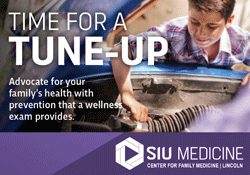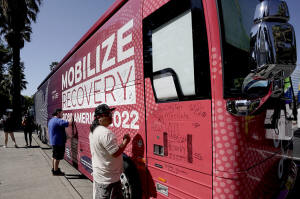How should the opioid settlements be spent? Those hit hardest often
don’t have a say
 Send a link to a friend
Send a link to a friend
 [December 09, 2024]
By GEOFF MULVIHILL [December 09, 2024]
By GEOFF MULVIHILL
People with substance use disorder across the country are not getting a
formal say in how most of the approximately $50 billion in opioid
lawsuit settlement money is being used to stem the crisis, a new
analysis found.
Some advocates say that is one factor in why portions of the money are
going to efforts they don't consider to be proven ways to save lives
from overdose, including equipment to scan jail inmates for contraband,
drug-sniffing police dogs and systems to neutralize unneeded
prescription medications.
In Jackson County, West Virginia, officials voted earlier this year to
use more than $500,000 in settlement funds for a first-responder
training center and a shooting range. They also allocated $35,000 to a
quick response team that works with overdose survivors.
Josh George, who has been in recovery for three years after 23 years of
drug use, primarily heroin, now runs a recovery group with his wife and
other family members.
Some of the money could have gone to the county's only recovery house,
he said.
“All these people were doing it on their own dime," George said, “trying
to help these people.”
Over the past eight years, drugmakers, wholesalers, pharmacy chains and
other companies have agreed to settlements to resolve thousands of
lawsuits filed by state, local and Native American tribal governments
claiming the companies’ practices contributed to the crisis.
Opioids have been a major problem in the U.S. since the late 1990s, with
the deadliest stretch earlier this decade reaching more than 80,000
annually. The major causes have shifted from prescription pills to
heroin to fentanyl and other lab-produced substances often added to
other illicit drugs.

Funds from the multi-billion dollar nationwide settlements began rolling
out in 2022 and will continue until at least 2038. The agreements
require most of the money be used to fight the crisis but offer great
flexibility in how to do it.
Christine Minhee of Opioid Settlement Tracker and Vital Strategies, a
public health organization, planned to release a state-by-state guide on
Monday outlining how government funding decisions are being made. The
guide aims to help advocates know where to raise their voices.
Using that information and other data, Minhee, who has tallied just
under $50 billion in settlements excluding one with OxyContin maker
Purdue Pharma that the Supreme Court rejected, found advisory groups
help determine spending of about half of it. But they have
decision-making authority over less than one-fifth of it.
Less than $1 in $7 is overseen by boards that reserve at least one seat
for someone who is using or has used drugs, though some places where
it's not required may have such members anyway.
Brandon Marshall, a professor of epidemiology at the Brown University
School of Public Health and a former member of the Rhode Island Opioid
Settlement Advisory Committee, said he has observed that processes
involving experts and people with drug use experience have made quick
allocations to groups working on harm reduction and other areas because
they know the groups.
“It’s not just a way to ensure that the funds are used effectively,” he
said. “Those kinds of systems are also ensuring the funds are getting
out the door faster.”
[to top of second column]
|

Sa Thao signs the 2022 Mobile Recovery National Bus, a nationwide
bus tour drawing attention to determine how billions in opioid
settlement money should be used, during a stop in Sacramento, Calif.
Sept. 7, 2022. (AP Photo/Rich Pedroncelli, File)
 Public health advocates say the
money should be used in ways proven to save lives, prevent drug use
and focus on racial equity and that the decisions should be
transparent.
But many communities are following regular government spending
practices rather than assessing local needs or consulting with
experts or people impacted by the epidemic.
Renville County, Minnesota, used $100,000 in settlement money to pay
about two-thirds of the cost of a body scanner for the county jail
to detect drugs on incoming inmates, even if they have swallowed
bags of them.
“You can’t possibly tell me that whoever made those decisions thinks
that’s the best use of the funding,” said Alicia House, executive
director of the Steve Rummler Hope Network, which provides overdose
prevention and education across Minnesota.
Renville County Sheriff Scott Hable said in an interview that
keeping drugs out of the jail — without subjecting people entering
to strip searches — fits with the facility’s emphasis on treatment
for inmates with substance use disorder.
The scanner has been used nearly 1,400 times since last year,
identifying contraband in six cases. Twice, it found packets of
drugs inmates swallowed before entering, he said.
The county’s governing body made the spending decision. Sara Benson,
the county’s public health director, said the government is
assembling an advisory group for future settlement use and wants to
include people with lived experience.
In West Virginia, Jackson County Commission President Dick Waybright
said the training center will help law enforcement, EMS and 911
employees respond to the opioid crisis.
“It wouldn't just be throwing money to a program that wasn’t going
to last,” he said in an interview. Besides, he said, no one else
besides the quick response team requested funds from the first
opioid settlement payment.
George's mother, Kelly DeWees, said there are many needs in an area
hit hard by addiction, including transportation for people in
recovery, prevention education and counseling for children of those
with substance use disorder. Breath of Life, the group her son and
daughter-in-law run, could use help launching a recovery home.
The group is requesting the $15,000 that currently remains in the
county’s fund and Waybright said he expects it to be awarded to them
soon.

For others, the spending decisions are even more personal.
Tonia Ahern, a community coordinator for the National Center for
Advocacy and Recovery, lost her son to an overdose when he was 29.
She co-founded a group planning to produce a handbook of suggestions
for New Jersey communities on how to use the funding.
“If you haven’t ever experienced it, you have no idea what they
need,” Ahern said.
All contents © copyright 2024 Associated Press. All rights reserved |